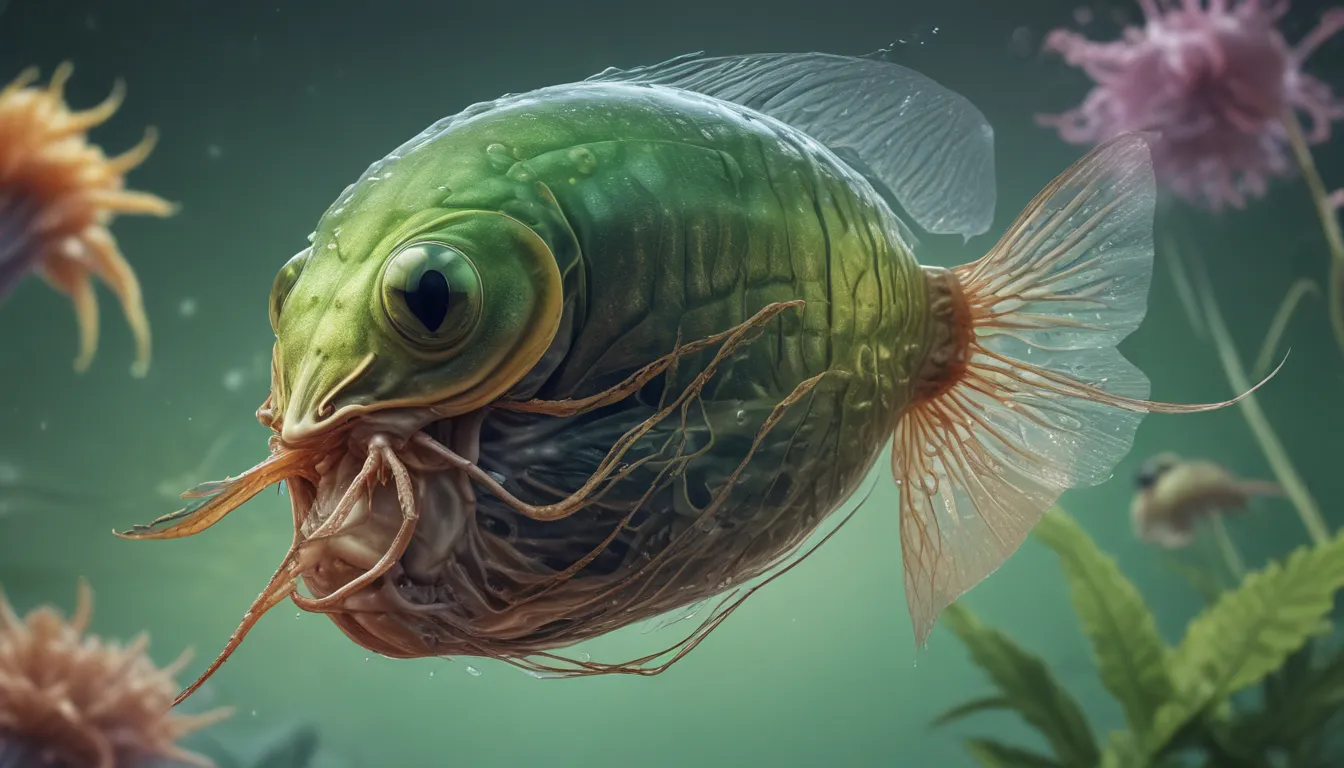A Note About Images: The images used in our articles are for illustration purposes only and may not exactly match the content. They are meant to engage readers, but the text should be relied upon for accurate information.
Are you curious about the tiny creatures that inhabit freshwater environments and hold immense significance in scientific research? Look no further than Daphnia, commonly known as water fleas. These fascinating organisms, with their unique characteristics and behaviors, have captured the attention of scientists worldwide. Join us on a journey to uncover 20 intriguing facts about Daphnia, shedding light on their biology, ecological importance, and contributions to scientific knowledge.
Unveiling the Wonders of Daphnia Pulex
Daphnia pulex, also known as the water flea, is a remarkable freshwater crustacean that plays a vital role in aquatic ecosystems. Despite its small size, this organism is a key player in ecological studies, serving as a model organism to investigate the impacts of pollutants, climate change, and other environmental factors. Its transparent body allows for easy observation of internal organs, making it invaluable for research in developmental biology and toxicology.
The Ecological Significance of Daphnia Pulex
As a filter feeder, Daphnia pulex consumes tiny particles suspended in water, influencing nutrient cycling and the overall health of aquatic environments. Its reproductive strategies, including asexual reproduction under favorable conditions and sexual reproduction in response to stress, offer insights into population dynamics and adaptation. Daphnia pulex also serves as a crucial food source for various aquatic organisms, contributing to freshwater ecosystem biodiversity.
- Daphnia pulex is a key organism in ecological studies due to its sensitivity to environmental changes and its role in the aquatic food web.
- Researchers often use Daphnia as a model organism to study the impacts of pollutants and climate change on freshwater ecosystems.
The Role of Daphnia Pulex in Controlling Algal Blooms
Daphnia pulex plays a vital role in controlling algal blooms by consuming algae, regulating their population, and preventing excessive growth. This natural mechanism helps maintain the ecological balance of freshwater ecosystems and highlights the importance of these tiny crustaceans in preserving aquatic health.
- Daphnia pulex helps regulate algal populations, maintaining water clarity and nutrient cycling in aquatic ecosystems.
- Its feeding activities contribute to the overall balance of the aquatic food web, impacting the entire ecosystem.
Daphnia Pulex as a Versatile Model Organism
In laboratory experiments, Daphnia pulex serves as a versatile subject for studying various biological processes such as circadian rhythms, phenotypic plasticity, and genetic diversity. Its transparent carapace allows for non-invasive physiological studies, offering insights into aging, immunity, and cardiovascular function. With a short lifespan and sensitivity to environmental factors, Daphnia pulex provides valuable information on life history traits and population dynamics.
- Daphnia pulex is commonly used in laboratory experiments to study biological processes such as aging, immunity, and reproductive physiology.
- Its transparent carapace facilitates non-invasive physiological studies, contributing to our understanding of cardiovascular function in small aquatic organisms.
Unraveling the Adaptive Traits of Daphnia Pulex
Daphnia pulex exhibits phenotypic plasticity, displaying different traits in response to environmental cues. This adaptability allows it to thrive in diverse aquatic habitats and withstand fluctuating environmental conditions. In the presence of predators, Daphnia pulex can develop defensive traits such as helmet formation and altered morphology, enhancing its chances of survival.
- Daphnia pulex shows phenotypic plasticity, adapting to environmental changes and thriving in diverse aquatic habitats.
- Its ability to develop defensive traits against predators underscores its adaptive prowess and survival strategies.
Exploring the Genetic Diversity of Daphnia Pulex
Genetic studies have revealed significant diversity among Daphnia pulex populations, reflecting their ability to adapt to local environmental conditions and contributing to the species’ evolutionary potential. As a subject of interest in evolutionary biology, Daphnia pulex offers valuable insights into adaptation, genetic diversity, and the interplay between environmental factors and evolutionary processes.
- Genetic studies have shown significant diversity among Daphnia pulex populations, highlighting their ability to adapt to environmental conditions.
- Daphnia pulex offers valuable insights into evolutionary processes, genetic diversity, and adaptation to changing environments.
Discovering the Circadian Rhythms of Daphnia Pulex
Daphnia pulex exhibits circadian rhythms, governing various physiological and behavioral processes in synchrony with the day-night cycle. The study of these rhythms provides insights into the regulation of biological functions in response to environmental cues, highlighting the intricate interactions between internal clocks and external environmental factors.
- Daphnia pulex displays circadian rhythms, regulating physiological and behavioral processes in synchronization with the day-night cycle.
- Studying these rhythms offers insights into the coordination of biological functions in response to environmental cues.
The Contribution of Daphnia Pulex to Nutrient Cycling
Through their feeding activities and excretion, Daphnia pulex significantly contributes to nutrient cycling in aquatic ecosystems, influencing the availability and distribution of essential elements such as carbon, nitrogen, and phosphorus. This role underscores the importance of these tiny creatures in maintaining the balance of freshwater ecosystems and promoting overall environmental health.
- Daphnia pulex plays a crucial role in nutrient cycling, influencing the availability and distribution of essential elements in aquatic ecosystems.
- Its feeding activities and excretion contribute to the overall balance of nutrient cycles, impacting the health of freshwater environments.
The Sensitivity of Daphnia Pulex to Environmental Factors
Daphnia pulex is sensitive to temperature changes, with variations affecting its metabolic rate, reproductive output, and overall physiological performance. Additionally, this species is sensitive to oxygen levels in water, with low oxygen concentrations negatively impacting its survival and reproductive success. Its responsiveness to environmental factors highlights its role as a bioindicator of water quality and underscores the importance of preserving aquatic ecosystems.
- Daphnia pulex exhibits sensitivity to temperature changes, influencing its metabolic rate and physiological performance.
- It is sensitive to oxygen levels in water, with low oxygen concentrations affecting its survival and reproductive success.
Conclusion
In conclusion, Daphnia pulex, also known as the water flea, is a tiny yet remarkable freshwater crustacean that has captivated the attention of scientists and researchers worldwide. This minuscule organism, with its unique characteristics and behaviors, plays a vital role in ecological studies and scientific research. Through its contributions to nutrient cycling, algal bloom control, and genetic diversity studies, Daphnia pulex has become a cornerstone in understanding freshwater ecosystems and their dynamics.
FAQs
-
What is the significance of Daphnia in scientific research?
Daphnia serves as a crucial model organism in various scientific disciplines, including ecology, toxicology, and evolutionary biology. Its transparent body and rapid reproduction make it an ideal subject for studying environmental responses and genetic variations. -
How does Daphnia contribute to aquatic ecosystems?
Daphnia plays a vital role in regulating algal populations, thereby influencing the overall balance of aquatic ecosystems. As a primary consumer, it helps maintain water clarity and nutrient cycling, impacting the entire food web.
Was this page helpful?
Our commitment to delivering trustworthy and engaging content is at the heart of what we do. Each fact on our site is contributed by real users like you, bringing a wealth of diverse insights and information. Trust in our commitment to quality and authenticity as you explore and learn with us.






